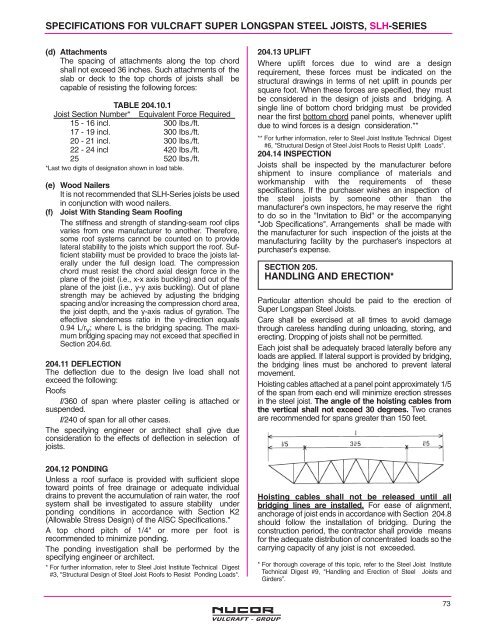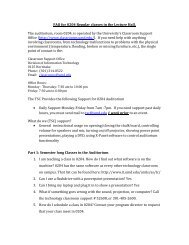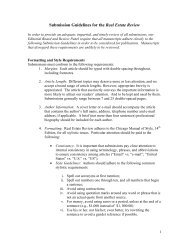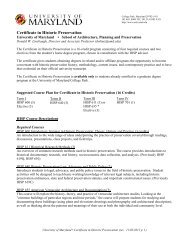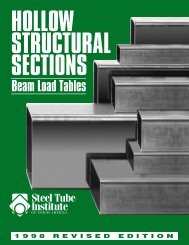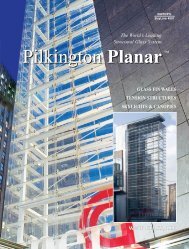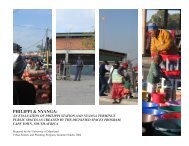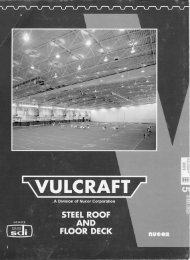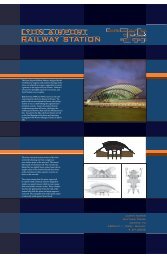Vulcraft_Joist_Catal..
Vulcraft_Joist_Catal..
Vulcraft_Joist_Catal..
- No tags were found...
You also want an ePaper? Increase the reach of your titles
YUMPU automatically turns print PDFs into web optimized ePapers that Google loves.
SPECIFICATIONS FOR VULCRAFT SUPER LONGSPAN STEEL JOISTS, SLH-SERIES<br />
(d) Attachments<br />
The spacing of attachments along the top chord<br />
shall not exceed 36 inches. Such attachments of the<br />
slab or deck to the top chords of joists shall be<br />
capable of resisting the following forces:<br />
TABLE 204.10.1<br />
<strong>Joist</strong> Section Number* Equivalent Force Required<br />
15 - 16 incl. 300 Ibs./ft.<br />
17 - 19 incl. 300 Ibs./ft.<br />
20 - 21 incl. 300 Ibs./ft.<br />
22 - 24 incl 420 Ibs./ft.<br />
25 520 Ibs./ft.<br />
*Last two digits of designation shown in load table.<br />
(e) Wood Nailers<br />
It is not recommended that SLH-Series joists be used<br />
in conjunction with wood nailers.<br />
(f) <strong>Joist</strong> With Standing Seam Roofing<br />
The stiffness and strength of standing-seam roof clips<br />
varies from one manufacturer to another. Therefore,<br />
some roof systems cannot be counted on to provide<br />
lateral stability to the joists which support the roof. Sufficient<br />
stability must be provided to brace the joists laterally<br />
under the full design load. The compression<br />
chord must resist the chord axial design force in the<br />
plane of the joist (i.e., x-x axis buckling) and out of the<br />
plane of the joist (i.e., y-y axis buckling). Out of plane<br />
strength may be achieved by adjusting the bridging<br />
spacing and/or increasing the compression chord area,<br />
the joist depth, and the y-axis radius of gyration. The<br />
effective slenderness ratio in the y-direction equals<br />
0.94 L/r y ; where L is the bridging spacing. The maximum<br />
bridging spacing may not exceed that specified in<br />
Section 204.6d.<br />
204.11 DEFLECTION<br />
The deflection due to the design live load shall not<br />
exceed the following:<br />
Roofs<br />
l/360 of span where plaster ceiling is attached or<br />
suspended.<br />
l/240 of span for all other cases.<br />
The specifying engineer or architect shall give due<br />
consideration to the effects of deflection in selection of<br />
joists.<br />
204.12 PONDING<br />
Unless a roof surface is provided with sufficient slope<br />
toward points of free drainage or adequate individual<br />
drains to prevent the accumulation of rain water, the roof<br />
system shall be investigated to assure stability under<br />
ponding conditions in accordance with Section K2<br />
(Allowable Stress Design) of the AISC Specifications.*<br />
A top chord pitch of 1/4" or more per foot is<br />
recommended to minimize ponding.<br />
The ponding investigation shall be performed by the<br />
specifying engineer or architect.<br />
* For further information, refer to Steel <strong>Joist</strong> Institute Technical Digest<br />
#3, "Structural Design of Steel <strong>Joist</strong> Roofs to Resist Ponding Loads".<br />
204.13 UPLIFT<br />
Where uplift forces due to wind are a design<br />
requirement, these forces must be indicated on the<br />
structural drawings in terms of net uplift in pounds per<br />
square foot. When these forces are specified, they must<br />
be considered in the design of joists and bridging. A<br />
single line of bottom chord bridging must be provided<br />
near the first bottom chord panel points, whenever uplift<br />
due to wind forces is a design consideration.**<br />
** For further information, refer to Steel <strong>Joist</strong> Institute Technical Digest<br />
#6, "Structural Design of Steel <strong>Joist</strong> Roofs to Resist Uplift Loads".<br />
204.14 INSPECTION<br />
<strong>Joist</strong>s shall be inspected by the manufacturer before<br />
shipment to insure compliance of materials and<br />
workmanship with the requirements of these<br />
specifications. If the purchaser wishes an inspection of<br />
the steel joists by someone other than the<br />
manufacturer's own inspectors, he may reserve the right<br />
to do so in the "Invitation to Bid" or the accompanying<br />
"Job Specifications". Arrangements shall be made with<br />
the manufacturer for such inspection of the joists at the<br />
manufacturing facility by the purchaser's inspectors at<br />
purchaser's expense.<br />
SECTION 205.<br />
HANDLING AND ERECTION*<br />
Particular attention should be paid to the erection of<br />
Super Longspan Steel <strong>Joist</strong>s.<br />
Care shall be exercised at all times to avoid damage<br />
through careless handling during unloading, storing, and<br />
erecting. Dropping of joists shall not be permitted.<br />
Each joist shall be adequately braced laterally before any<br />
loads are applied. If lateral support is provided by bridging,<br />
the bridging lines must be anchored to prevent lateral<br />
movement.<br />
Hoisting cables attached at a panel point approximately 1/5<br />
of the span from each end will minimize erection stresses<br />
in the steel joist. The angle of the hoisting cables from<br />
the vertical shall not exceed 30 degrees. Two cranes<br />
are recommended for spans greater than 150 feet.<br />
Hoisting cables shall not be released until all<br />
bridging lines are installed. For ease of alignment,<br />
anchorage of joist ends in accordance with Section 204.8<br />
should follow the installation of bridging. During the<br />
construction period, the contractor shall provide means<br />
for the adequate distribution of concentrated loads so the<br />
carrying capacity of any joist is not exceeded.<br />
* For thorough coverage of this topic, refer to the Steel <strong>Joist</strong> Institute<br />
Technical Digest #9, "Handling and Erection of Steel <strong>Joist</strong>s and<br />
Girders”.<br />
73


